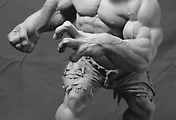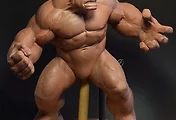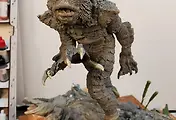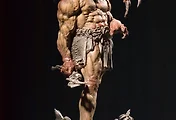Firedrake Dragon Maquette
Dimensions: H 30″ L 18″ W 14″
Bronze: Limited Edition of 12
Description
Firedrake Dragon Maquette
A hyper-realistic 1/12th scale sculpture of a Dragon. If Dragons were real, they could look like this – wing loading and anatomy are all workable for the real world. This beast could really fly.
For those of you with an interest in the imaginary evolution and behaviour of dragons, below are my thoughts, to date, on the evolution, anatomy and behaviour of my own particular Dragon. Enjoy my journey, then let your own imagination take flight!
My dragon has evolved from an archosaurian ancestor, so the basic anatomy is inspired by related groups – pterosauria, dinosauria (particularly theropoda), aves and crocodilia. The skull is relatively heavily built for a flying creature, though the internal structure of the bones would follow an avian/pterosaur pattern – hollow and light, with thin walls strengthened and supported by internal struts, with the skull further lightened by large openings (fenestrae) within the skull itself. A carnivore taking prey in mid flight, the jaws and teeth are based on related species that feed predominantly on smaller, fast-moving prey (fish, birds and flying insects).
I envisage my dragon feeding mainly on other airborne creatures (with some larger, ground-based prey - more on that later). It has large eyes and binocular vision – it’s main hunting sense is vision. In addition to it’s other teeth, my dragon has specialised fangs, rather like those of spitting cobras. But my dragon does not spit venom, it spits fire. Spitting a highly pyrophoric (ignites on contact with the air) liquid called triethylaluminium, which it synthesises in special ‘venom’ glands, having ingested aluminium-rich ores, such as bauxite.
I have sculpted the dragon just prior to spitting fire, in full threat display. The eyelids are rolling up to protect the eyes; the nictitating membrane is also starting to move over, to further protect the eyes.
My dragon has a muscular throat pouch, which is distended. This pouch can be distended during territorial/mating displays, to show the brightly coloured skin between the scales and to act as a sound box, amplifying their booming calls.
As the dragon spits flaming venom, it exhales strongly. The muscles in the throat pouch simultaneously contract, focussing and amplifying the blast of air as the ‘venom’ is released, propelling the flaming venom towards it’s target and out and away from the dragon itself.
Spitting fire originally evolved in smaller ancestors as a defence mechanism, later used during courtship displays, before becoming the Dragon’s primary weapon and means of killing it’s prey. As with evolution in hominins, the use of fire to cook food, increased the amount of energy available per kilo consumed. This supports the development of a larger brain. So my dragon is intelligent, bordering on sentient.
Because my dragon is an adult male, it has a dorsal head crest, which is erected during courtship, territorial and threat displays. Fire is rarely used against rival males during competition for territory or females - though the males and females both blow fireballs into the air during display flights, in an effort to attract a mate.
During courtship disputes, males first deter rivals with a threat display - head bobbing and swaying, flashing their head crest, gaping their mouths, inflating their throat pouches and blasting fire into the air, followed by contests of strength – clashing their armoured heads and pushing and wrestling with their armoured, muscular, necks. Only heads and necks are used for combat, because the risk of damaging their relatively fragile wing membranes is too great to involve the whole body. Males necks thicken and become more muscular during mating season which aids in these pushing contests of strength.
As I mentioned, I envisage dragons evolving to hunt other flying creatures predominantly. Killing by ‘roasting’ them in mid flight, then snatching them out of the air as they fall. To facilitate this, the jaw has a double hinge, allowing it to open very wide, meaning that several smaller prey animals can be snapped up simultaneously (and coincidentally, keeping everything clear of flaming venom as it spits). Larger prey would be ‘shot down’ then dismembered on the ground, using it’s scythe-like wing claws and two dromeosaur-like hind claws, before being devoured in smaller chunks, swallowed without chewing.
The flight anatomy is derived from that of pterosaurs, birds and bats. My dragon had an open lung system, like that of pterosaurs and birds, with air sacs throughout the skeleton and wings to increase lung capacity, with a lightweight, but muscular body, containing a preponderance of fast-twitch muscle fibres, giving a tremendous power to weight ratio. This means that, theoretically, my dragon could attain a maximum wingspan of around 50 feet. More than capable of tackling large, ground-based, prey, if necessary (including the occasional knight errant?) first roasting with a blast of pyrophoric venom, before landing to dismember and devour.
My Firedrake, were it real, would be a truly fearsome beast; worthy of the name, “Dragon” !!






















































'크리쳐 Creature > 미분류' 카테고리의 다른 글
| 헐크 사이드쇼 SIDESHOW Hulk (0) | 2022.06.15 |
|---|---|
| 헐크 Hulk (0) | 2022.06.14 |
| 길맨 해양괴물 Gillman Creature from the Black Lagoon (0) | 2022.06.10 |
| 올 스크랫취 Ol' Scratch (0) | 2022.06.09 |
| 가이버 베이더 매시업 흉상 Bioboosted Vader (0) | 2022.06.07 |



